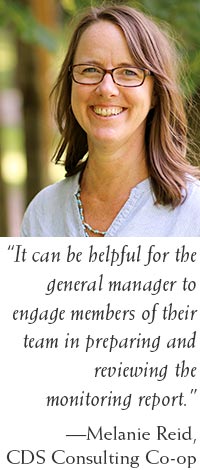The Board’s Job
Creating board policies is no easy task. Clearly articulating the board’s expectations of a general manager takes a lot of energy and focus—so boards can justifiably congratulate themselves once they’ve written down their expectations in a way that a manager can easily understand.
But the board’s work doesn’t end there. Many boards, once they’ve created their policies and learned to empower—rather than control, their manager—then fail to rigorously monitor results! Delegating fulfills only half of a board’s fiduciary responsibility—checking to see what has actually been accomplished completes the task.
While the Monitoring Report Decision Tree, and the “What to Do with Unacceptable Monitoring Reports: Field Guide” are essential tools in understanding how boards engage with monitoring reports, boards may still miss an important function of monitoring—it helps the board clarify its expectations of the general manager.
Discussion and examination of the data the general manager presents, and the ensuing board conversation, help the board and general manager reach shared understanding. Did the board ask for what it wanted? Does the data the general manager provides demonstrate accomplishment? Or would other data be more appropriate? Is more explanation required? Useful monitoring reports give the board the opportunity to see how the general manager has turned policy into operational reality, helping the board understand various aspects of the co-op’s operations.
One caution, the board has hired a general manager to accomplish results, and while you need them to demonstrate those results through reporting, you also need to recognize that time spent on reporting limits the time the general manger can commit to other accomplishments. Be thorough in your monitoring, but not excessive.
The General Manager’s Job
 When thinking about providing data for monitoring, a general manager should seek to answer three key questions:
When thinking about providing data for monitoring, a general manager should seek to answer three key questions:
- What data points best support the interpretation?
- Is the data sufficient and reliable?
- How will the data be used beyond monitoring?
Once the board has provided clear expectations (through clear policy language) the general manager uses their interpretation as a way to describe how they think about a policy from an operational perspective.
Here’s an example from a Staff Treatment & Compensation policy:
Policy: The GM must not:
1. Cause or allow personnel policies to be inconsistently applied.
Interpretation: I interpret this to mean that all co-op employees will be held accountable to the same standards, policies, and procedures.
The next step is to determine what data points will best support the interpretation. Think of data like supporting evidence. Depending on the limitation and the interpretation, you may choose to provide one or more data points. Quality is generally more important than quantity. Try to show sufficient data as efficiently as possible.
This example shows how a general manager might use data from a staff survey to demonstrate compliance with the above interpretation:
Data: Survey Results:
| Compliance benchmark | Survey Scores | Does data indicate compliance? Y/N | |
| Q8. To the best of my knowledge, the personnel policies are applied fairly and consistently to all co-op employees. | Score of 3.25 or above | 3.53 | Y |
| Q23. Department expectations are upheld in a fair and consistent way for all department employees. | Score of 3.25 or above | 3.67 | Y |
| Q10. To the best of my knowledge, management follows established policy when taking corrective action. | Score of 3.25 or above | 3.80 | Y |
| Q37. My supervisor promptly addresses performance problems in my department. | Score of 3.25 or above | 3.88 | Y |
 The data must not only be sufficient, it also needs to be reliable. In the same way that the numbers included in a report on financial condition must be current and accurate, data for softer policies must be reliable as well. For example, the data used here is from an employee satisfaction survey that 95% of the staff participated in. This high participation rate ensures the reliability of the data. Had 60% of the staff participated, it would be more difficult to assert that the data is reliable.
The data must not only be sufficient, it also needs to be reliable. In the same way that the numbers included in a report on financial condition must be current and accurate, data for softer policies must be reliable as well. For example, the data used here is from an employee satisfaction survey that 95% of the staff participated in. This high participation rate ensures the reliability of the data. Had 60% of the staff participated, it would be more difficult to assert that the data is reliable.
Depending on the data and the method of collecting, it can be helpful for the general manager to engage members of their team in preparing and reviewing the monitoring report. For example, working collaboratively with the finance manager in writing the quarterly financial conditions report allows for an additional set of eyes to review the data before it’s presented to the board. This ensures accuracy and creates an added layer of checks and balances.
And finally, collecting the data takes time and resources. When possible, consider using data that is valuable beyond the report. Choose data points that provide useful information for building operational plans and systems. For example, if the goal for sales growth is 8% and the data shows sales growth of 6%, operational plans may need to be adjusted to increase growth. Similarly, if staff survey data shows that staff members are unaware of a policy or procedure, management should use those findings when developing training programs or in considering how information is being delivered to staff members.
Here’s another example from a staff survey showing an action plan:
Data: Survey Results:
| Compliance benchmark | Survey Scores | Does data indicate compliance? Y/N | |
| Q11. The conflict resolution procedure provides a safe method for airing and resolving workplace conflicts. | Score: 3.25 or above | 2.72 | N |
Action Plan: The score on Q11 is below the recommended benchmark for compliance. Given the level of dissatisfaction in this area, management commits to taking immediate action by including an explanation of the conflict resolution procedure as part of new hire orientation for incoming staff members, and offering information on the procedure to all staff members as part of the response to these survey results. The desired outcome being to provide information that will, hopefully, build greater confidence in the procedure. Follow-up will be needed with another survey to determine whether progress is made.
Achieving Alignment
Part of the beauty of the co-operative model is the commitment to developing and encouraging everyone’s best talents. Writing and reviewing monitoring reports can be a powerful exercise when considered in this context. While the tasks are somewhat different—general managers are charged with managing a lot of details and boards are charged with being sure expectations are clear—monitoring can serve as a way to ensure the board and manager are aligned and that the organization is achieving optimum performance.
Have more questions?
Get in touch with one of our consultants.



